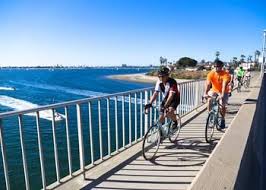JOIN OUR NEWSLETTER MAILING LIST AND GET IN THE GAME
December 16th, 2023 Holiday Spikeball Hat Tournament in Pacific Beach Benefiting SDSL At-Risk Youth Programs
the health and wellness benefits of cycling
To be fit and healthy you need to be physically active. Regular physical activity can help protect you from serious diseases such as obesity, heart disease, cancer, mental illness, diabetes and arthritis. Riding your bicycle regularly is one of the best ways to reduce your risk of health problems associated with a sedentary lifestyle.
Cycling is a healthy, low-impact exercise that can be enjoyed by people of all ages, from young children to older adults. It is also fun, cheap and good for the environment.
Riding to work or the shops is one of the most time-efficient ways to combine regular exercise with your everyday routine. An estimated one billion people ride bicycles every day – for transport, recreation and sport.

Low impact – it causes less strain and injuries than most other forms of exercise.
A good muscle workout – cycling uses all of the major muscle groups as you pedal.
Easy – unlike some other sports, cycling does not require high levels of physical skill. Most people know how to ride a bike and, once you learn, you don’t forget.
Good for strength and stamina – cycling increases stamina, strength and aerobic fitness.
As intense as you want – cycling can be done at very low intensity to begin with, if recovering from injury or illness, but can be built up to a demanding physical workout.
A fun way to get fit – the adventure and buzz you get from coasting down hills and being outdoors means you are more likely to continue to cycle regularly, compared to other physical activities that keep you indoors or require special times or places.
Time-efficient – as a mode of transport, cycling replaces sedentary (sitting) time spent driving motor vehicles or using trams, trains or buses with healthy exercise.
increased cardiovascular fitness
increased muscle strength and flexibility
improved joint mobility
decreased stress levels
improved posture and coordination
strengthened bones
decreased body fat levels
prevention or management of disease
reduced anxiety and depression.
Cycling is a good way to control or reduce weight, as it raises your metabolic rate, builds muscle and burns body fat. If you’re trying to lose weight, cycling must be combined with a healthy eating plan. Cycling is a comfortable form of exercise and you can change the time and intensity – it can be built up slowly and varied to suit you.
Research suggests you should be burning at least 8,400 kilojoules (about 2,000 calories) a week through exercise. Steady cycling burns about 1,200 kilojoules (about 300 calories) per hour.
If you cycle twice a day, the kilojoules burnt soon add up. British research shows that a half-hour bike ride every day will burn nearly five kilograms of fat over a year.
Cardiovascular diseases include stroke, high blood pressure and heart attack. Regular cycling stimulates and improves your heart, lungs and circulation, reducing your risk of cardiovascular diseases.
Cycling strengthens your heart muscles, lowers resting pulse and reduces blood fat levels. Research also shows that people who cycle to work have two to three times less exposure to pollution than car commuters, so their lung function is improved. A Danish study conducted over 14 years with 30,000 people aged 20 to 93 years found that regular cycling protected people from heart disease.
Cycling improves strength, balance and coordination. It may also help to prevent falls and fractures. Riding a bike is an ideal form of exercise if you have osteoarthritis because it is a low-impact exercise that places little stress on joints.
Cycling does not specifically help osteoporosis (bone-thinning disease) because it is not a weight-bearing exercise.
Mental health conditions such as depression, stress and anxiety can be reduced by regular bike riding. This is due to the effects of the exercise itself and because of the enjoyment that riding a bike can bring.
Hand cycles are similar to recumbent tricycles, but they are powered with hand instead of foot pedals. Velcro straps can be used to secure the hands to the pedals if necessary.
This style of tricycle allows amputees, people with spinal injuries and those recovering from certain conditions such as stroke to cycle as a form of exercise and recreation. Hand cyclists get cardiovascular and aerobic benefits similar to those of other cyclists.
